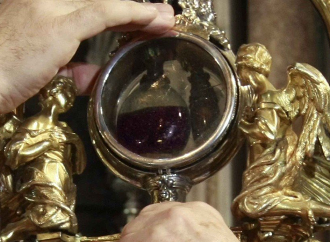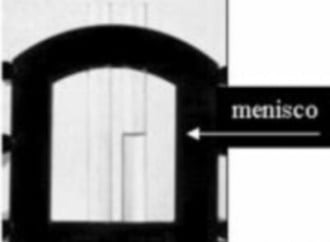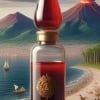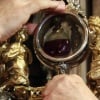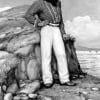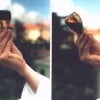J. Soc. Psyc. Res., 62, 852 , 417 (1998)
ABSTRACT
A relic representing the blood of St Lorenzo, which periodically liquefies from its usual clotted state in a purportedly supernatural manner, has been examined and found to consist of a substance melting at ca 30 degrees.
The study of miracles, i.e. paranormal phenomena of a religious or cultist nature, has proven to be even more elusive than the examination of paranormal events of the secular realm. This is, of course, the result of protection by the religious authority, which may feel either that the event needs no examination and should be accepted on faith, or that the investigation can only be performed by members of the religion or cult who already believe in the divine nature of the miracle.
Cooperation between secular and religious authorities in the investigation of miracles, such as was realized in the study of the Shroud of Turin (Damon et al., 1989; Nickell, 1987) is the exception rather than the rule.
Miracles that can be conclusively studied by investigators using hard scientific disciplines, such as chemistry and physics, are limited to physical miracles of a nonmedical nature, that is, those miracles that are visible to more than one observer, are manifested as physical and paranormal phenomena, and do not involve healings.
The Roman Catholic Church has a long history of extensive investigation of miracles, but only in very few cases have physical miracles of a nonmedical nature been accepted as evidence for sanctity or as caused by a special divine intervention. Examples include miraculous images, weeping icons, and unexplained transformations of physical state (i.e., coagulated blood that liquefies).
The "weeping Madonna" in Siracusa (Italy), who reportedly shed tears in 1953, was declared by the local bishop to be a genuine miracle just four months after the phenomenon took place (Rogo, 1983; Garlaschelli, 1995). In other cases the Church has traditionally been much more cautious, preferring not to express itself as to the genuinity of the event, (which can however be declared of prodigious nature), still allowing its cult, as long as this is doctrinairly sound.
Among the religious relics of this type still venerated by the Roman Catholic Church are remains of the blood of early saints.
In Italy only, particularly clustered near Neaples, there are some 190 blood relics (Alfano & Amitrano, 1951). A small number of these samples become liquefied from their usual clotted state - in a purportedly paranomal manner - on specific occasions, generally during religious ceremonies.
When blood is drawn from a living body and poured into a container, the soluble serum protein fibrinogen forms a network of insoluble fibrin, which in turn binds the erythrocytes resulting in a jelly-like clot. This clot can be mechanically broken down, but when this has been done once, no further change of state can reoccur. Thus, the resolidification of a blood sample would be even more surprising than its first liquefaction.
The most celebrated of these miraculous relics is a vial containing a dark, unknown substance, considered to be the blood of St Januarius, that has been liquefied once or twice a year since 1389 in Naples (Alfano & Amitrano, 1921). St Januarius was an early bishop of Benevento, who was beheaded during the persecution of the Emperor Diocletian in A.D. 305. The relic representing his blood appeared in Neaples more than ten centuries later, around 1389. Other relics of this kind, wherein the phase transition is evident and genuine, are the blood of St Pantaleone in Ravello (Avellino) and that of St Lorenzo (St Lawrence) in Amaseno (Frosinone), whose visual properties and behaviour appear extremely similar (Alfano & Amitrano, 1951).
Some years ago we proposed (Garlaschelli, Ramaccini & Della Sala, 1991; 1994) that thixotropy may furnish an explanation for the properties of the Januarian blood. Thixotropy denotes the property of certains gels to liquefy when stirred or vibrated, and to solidify again when left to stand. The very act of handling the relic during the ceremony, repeatedly turning it upside down to check its state, can provide the necessary shear force to trigger its liquefaction. In support of our hypothesis we also succeeded in preparing thixotropic samples, closely resembling the Januarian relic, using materials and techniques available in the fourteenth century.
Although the Januarian relic is subjected to many mechanical stresses, however, the large vial containing the blood of St Pantaleone (becoming liquefied around 27 July) is never moved, as it is locked behind a grating; and that of St Lorenzo is gently moved only once, on 10 August, from its niche to the altar. In these cases, then, thixotropy cannot be the explanation. Moreover, it appears that the liquefaction begins days before the feast day, and ends much later (precise day-to-day records are lacking).
St Lorenzo was martyred on 10 August 258 A.D., under the Roman Emperor Valerian, by being charred on a grill, and his popularity as a saint was always great during the Middle Age (Boccaccio, XIV century) and up to our days. The most famous of the relics of St Lorenzo still existing is a small flask which allegedly contains his blood and which is venerated in the collegiate church of St Maria in the small town of Amaseno (Frosinone). The relic is normally locked in a silver tabernacle in the right wing of the church. A few days before the saint's feast the niche is sometimes unlocked and the state of the relic inspected. On the morning of 10 August, then, the relic is brought near the altar, put onto a baroque stand, and locked into a glass cabinet. There, any further transformation of its state can be witnessed by the worshippers. A cerimony is held, on that same day, in the presence of the bishop from Frosinone; at evening the relic is locked again in its niche, and sometimes its further changes in the following days are checked by opening the safe a few times. No physical, chemical or spectroscopical tests have ever been performed on this relic.
On 10 August 1996 I had the permission to examine the small flask on the occasion of a TV documentary run by a crew of the Italian state television, Rai 2. I had brought with me a number of equipments in order to perform a few simple tests: a camera, a caliper, an electronic balance, a test-tube whirler, chemist's clamps, laboratory metal stands, thermomethers, beakers, etc.
The relic consists of a small glass flask, 15.3 cm high and of the weight of 141.8 g (mean of three measures on an Acculab electronic balance). It has the shape of an inverted cone, connected to a long neck of the diameter of 2.5 cm. The bottle is closed with a cork that can not be removed as it is secured by red strings, red wax seals and an old discoloured bishop's label. However, the cork is clearly not air-tight.
The vial contains an estimated amount of 35 ml of a mixture of substances. On the bottom there is a lumpy, tan-coloured layer, possibly containing sand or earth. A very tiny piece of darker material in this layer was traditionally interpreted by believers as being a particle of the coal on which the Saint was martyred. A few observer even claim to see a piece of the saint's charred skin Giannetta, 1964?). On top of this layer there is a second one, normally in the solid state, also brownish, topped by a third, thin, more amorphous layer. When liquefied, the middle layer becomes clear, changes its colour to ruby red, and flows freely if the flask is tilted slightly. The bottom layer always remains solid and the top one sometimes becomes partly liquefied. When I examined the relic, the middle layer was liquid while the other two layers were still opaque and solid.
I whirled the ampoule for 10 s on a Maxi Mixer test-tube mixer to check for a possible stress-induced thixotropic phase transition, but the only result was that the two uppermost layers became slightly mixed. The bottom layer remained unchanged, and a further 10 s whirling failed to alter the fluidity of the viscous contents.
I then cooled down the small flask by clamping it at the neck and immersing its lower part into a water-ice bath. After a few minutes, the entire contents solidified into an opaque tan-coloured mass.
Finally, I slowly re-warmed the water bath again to the initial room temperature (29-30 °C) by placing a hair-dryer under it, while monitoring its temperature by a chemistry thermometer. At 29 - 30 °C the contents of the flask melted again, and its colour turned red, thus clearly demonstrating that the observed change is simply a temperature-related effect of a low-melting- point compound.
The red substance cannot possibly be blood, since whole blood is typically opaque; even a clear haemoglobin solution would have decomposed and lost its bright red colour over the centuries; and a water solution would have dried up from the imperfectly sealed flask, and would not freeze at 30 °C.
The softening temperature and the overall look suggest that the relic consists of fats, waxes, or mixtures thereof, possibly containing an appropriate oil-soluble red dye. As a matter of fact, this relic is described in the church consecration act scroll (1177) as reliquia de pinguedine St. Laurentii Mart. (relic from the fat of the martyr Saint Lorenzo). The liquefaction phenomenon was not observed until the XVII century, when it became dubbed "fat and blood" and finally just "blood". This fact might even raise the suspicion that the early relic was at that time substituted for the present one (possessing evident liquefying properties).
It is interesting to notice that one of the hypothesis to explain the behaviour of the blood of St Januarius was that the unknown substance is simply a mixture with a low melting point. Solid when stored in a somewhat cooler place, it would melt when taken to the warmer altar, near burning candles, amidst a fervent crowd. This hypothesis was first recorded as early as 1826 (Salverte, 1826) and was quickly supported by numerous recipes, mostly based upon waxes, fats or gelatines (plus suitable dyes). A practical, not anachronistic one, was recently suggested by Nickell and Fisher (1993). In any case, mixtures such as these have a constant melting point, whereas the blood-liquefaction ceremony can be performed at different room temperatures (May, September, December). Thus, in the case of the Januarian blood, the thixotropic hypothesis seems more plausible.
However, contrarily to the Januarian relic, the "blood" of St Lorenzo is not contained in a sealed flask. A tiny drop of the substance, extracted with a syringe through the somewhat loose cork, might easily be analyzed by standard spectroscopic and chromatographic methods (UV-VIS and IR spectrophotometry, GC-MS, HPLC, etc.) and the nature of the red dye and that of the low melting point mixture could be elucidated.
Almost any substance melting in that range would do; it is tempting, however, to think of fats or waxes. Fats, in particular, would be rather easily analyzed. The type and the relative amount of the different fatty acids obtained by hydrolysis of triglycerides (fats), in fact, are a sort of "fingerprint" often allowing the identification of the specific oil or fat, namely to distinguish, for example, among sunflower, linseed, or coconut oils, tallow, etc.
What now can be said, by way of speculation, is that the "blood" of St Lorenzo looks very similar, for example, to the so called "red palm oil", a vegetable fat extracted from the plants Elaeis guineensis : this alimentary fat contains reddish-orange carotenes, is yellowish when solid, and deep orange when liquid; this colour change, and its exotic origin, might well have elicited fantasies about its miraculous properties. Its melting point (around 17 °C), however, is lower than that of the unknown "blood", and its colour seems to be more orange than red. Thus, unless it was mixed with other higher-melting compounds, better candidates might exist: coconut butter, tallow, etc. These fats are colourless and would call for the addition of suitable dyes.
Chemically, a preponderance of saturated fatty acids in the triglycerides leads to substantially higher melting fats. Saturated fats are also more resistent to oxidation, bringing to rancidity. Since the relic's substance appears to have been fairly stable along the centuries, one should suppose a large amount of saturated fatty acids in it. Even more stable are waxes, which, however, generally have a higher melting point.
The first fat-soluble red dye that comes to mind, which has the right red hue and was widely used during the Middle age (Cennini, XIV cent.), is "dragon's blood", a vegetable resin extracted from the plants Daemonorops propinquus (The Merck Index, 1989), Dracoena draco, (Thompson, 1936; Edwards, Farwell & Quye, 1977), or Calamus draco Willd. (Villavecchia - Eigenmann, 1977).
Clearly, these are just speculations. As stated above, the relic representing the blood of St Pantaleone in Ravello also seems to behave in an exactly similar manner, and has the same visual properties. So, it would be even more interesting to obtain exact data on both these maybe-not-so-miraculous substances.
The simplest check - that we have recommended to the relic's keepers - is a regular daily record of the state of the substance versus the temperature. Conclusive analysis, of course, should be of chemical and instrumental (Edwards, Farwell & Quye, 1977) nature. The permission to perform such tests, however, has not, so far, been given by the Church authorities.
The author wishes to thank Father Italo Pisterzi, Church of St Maria, Amaseno, for the permission to examine the relic; Rai 2 and director Gianni Romano for making this investigation feasible; his colleague Franco Ramaccini for bringing the properties of red palm oil to his attention, and for useful discussions and suggestions.
A preliminary report on this investigation appeared in Chemistry in Britain, August 1997, p. 18.
Luigi Garlaschelli
Dipartimento di Chimica Organica
University of Pavia
Via Taramelli 10
27100 Pavia - Italy
ABSTRACT
A relic representing the blood of St Lorenzo, which periodically liquefies from its usual clotted state in a purportedly supernatural manner, has been examined and found to consist of a substance melting at ca 30 degrees.
Indice |
The study of miracles, i.e. paranormal phenomena of a religious or cultist nature, has proven to be even more elusive than the examination of paranormal events of the secular realm. This is, of course, the result of protection by the religious authority, which may feel either that the event needs no examination and should be accepted on faith, or that the investigation can only be performed by members of the religion or cult who already believe in the divine nature of the miracle.
Cooperation between secular and religious authorities in the investigation of miracles, such as was realized in the study of the Shroud of Turin (Damon et al., 1989; Nickell, 1987) is the exception rather than the rule.
Miracles that can be conclusively studied by investigators using hard scientific disciplines, such as chemistry and physics, are limited to physical miracles of a nonmedical nature, that is, those miracles that are visible to more than one observer, are manifested as physical and paranormal phenomena, and do not involve healings.
The Roman Catholic Church has a long history of extensive investigation of miracles, but only in very few cases have physical miracles of a nonmedical nature been accepted as evidence for sanctity or as caused by a special divine intervention. Examples include miraculous images, weeping icons, and unexplained transformations of physical state (i.e., coagulated blood that liquefies).
The "weeping Madonna" in Siracusa (Italy), who reportedly shed tears in 1953, was declared by the local bishop to be a genuine miracle just four months after the phenomenon took place (Rogo, 1983; Garlaschelli, 1995). In other cases the Church has traditionally been much more cautious, preferring not to express itself as to the genuinity of the event, (which can however be declared of prodigious nature), still allowing its cult, as long as this is doctrinairly sound.
BLOOD MIRACLES
Among the religious relics of this type still venerated by the Roman Catholic Church are remains of the blood of early saints.
In Italy only, particularly clustered near Neaples, there are some 190 blood relics (Alfano & Amitrano, 1951). A small number of these samples become liquefied from their usual clotted state - in a purportedly paranomal manner - on specific occasions, generally during religious ceremonies.
When blood is drawn from a living body and poured into a container, the soluble serum protein fibrinogen forms a network of insoluble fibrin, which in turn binds the erythrocytes resulting in a jelly-like clot. This clot can be mechanically broken down, but when this has been done once, no further change of state can reoccur. Thus, the resolidification of a blood sample would be even more surprising than its first liquefaction.
The most celebrated of these miraculous relics is a vial containing a dark, unknown substance, considered to be the blood of St Januarius, that has been liquefied once or twice a year since 1389 in Naples (Alfano & Amitrano, 1921). St Januarius was an early bishop of Benevento, who was beheaded during the persecution of the Emperor Diocletian in A.D. 305. The relic representing his blood appeared in Neaples more than ten centuries later, around 1389. Other relics of this kind, wherein the phase transition is evident and genuine, are the blood of St Pantaleone in Ravello (Avellino) and that of St Lorenzo (St Lawrence) in Amaseno (Frosinone), whose visual properties and behaviour appear extremely similar (Alfano & Amitrano, 1951).
Some years ago we proposed (Garlaschelli, Ramaccini & Della Sala, 1991; 1994) that thixotropy may furnish an explanation for the properties of the Januarian blood. Thixotropy denotes the property of certains gels to liquefy when stirred or vibrated, and to solidify again when left to stand. The very act of handling the relic during the ceremony, repeatedly turning it upside down to check its state, can provide the necessary shear force to trigger its liquefaction. In support of our hypothesis we also succeeded in preparing thixotropic samples, closely resembling the Januarian relic, using materials and techniques available in the fourteenth century.
Although the Januarian relic is subjected to many mechanical stresses, however, the large vial containing the blood of St Pantaleone (becoming liquefied around 27 July) is never moved, as it is locked behind a grating; and that of St Lorenzo is gently moved only once, on 10 August, from its niche to the altar. In these cases, then, thixotropy cannot be the explanation. Moreover, it appears that the liquefaction begins days before the feast day, and ends much later (precise day-to-day records are lacking).
THE BLOOD OF ST LORENZO
St Lorenzo was martyred on 10 August 258 A.D., under the Roman Emperor Valerian, by being charred on a grill, and his popularity as a saint was always great during the Middle Age (Boccaccio, XIV century) and up to our days. The most famous of the relics of St Lorenzo still existing is a small flask which allegedly contains his blood and which is venerated in the collegiate church of St Maria in the small town of Amaseno (Frosinone). The relic is normally locked in a silver tabernacle in the right wing of the church. A few days before the saint's feast the niche is sometimes unlocked and the state of the relic inspected. On the morning of 10 August, then, the relic is brought near the altar, put onto a baroque stand, and locked into a glass cabinet. There, any further transformation of its state can be witnessed by the worshippers. A cerimony is held, on that same day, in the presence of the bishop from Frosinone; at evening the relic is locked again in its niche, and sometimes its further changes in the following days are checked by opening the safe a few times. No physical, chemical or spectroscopical tests have ever been performed on this relic.
On 10 August 1996 I had the permission to examine the small flask on the occasion of a TV documentary run by a crew of the Italian state television, Rai 2. I had brought with me a number of equipments in order to perform a few simple tests: a camera, a caliper, an electronic balance, a test-tube whirler, chemist's clamps, laboratory metal stands, thermomethers, beakers, etc.
TESTS ON THE RELIC
The relic consists of a small glass flask, 15.3 cm high and of the weight of 141.8 g (mean of three measures on an Acculab electronic balance). It has the shape of an inverted cone, connected to a long neck of the diameter of 2.5 cm. The bottle is closed with a cork that can not be removed as it is secured by red strings, red wax seals and an old discoloured bishop's label. However, the cork is clearly not air-tight.
The vial contains an estimated amount of 35 ml of a mixture of substances. On the bottom there is a lumpy, tan-coloured layer, possibly containing sand or earth. A very tiny piece of darker material in this layer was traditionally interpreted by believers as being a particle of the coal on which the Saint was martyred. A few observer even claim to see a piece of the saint's charred skin Giannetta, 1964?). On top of this layer there is a second one, normally in the solid state, also brownish, topped by a third, thin, more amorphous layer. When liquefied, the middle layer becomes clear, changes its colour to ruby red, and flows freely if the flask is tilted slightly. The bottom layer always remains solid and the top one sometimes becomes partly liquefied. When I examined the relic, the middle layer was liquid while the other two layers were still opaque and solid.
I whirled the ampoule for 10 s on a Maxi Mixer test-tube mixer to check for a possible stress-induced thixotropic phase transition, but the only result was that the two uppermost layers became slightly mixed. The bottom layer remained unchanged, and a further 10 s whirling failed to alter the fluidity of the viscous contents.
I then cooled down the small flask by clamping it at the neck and immersing its lower part into a water-ice bath. After a few minutes, the entire contents solidified into an opaque tan-coloured mass.
Finally, I slowly re-warmed the water bath again to the initial room temperature (29-30 °C) by placing a hair-dryer under it, while monitoring its temperature by a chemistry thermometer. At 29 - 30 °C the contents of the flask melted again, and its colour turned red, thus clearly demonstrating that the observed change is simply a temperature-related effect of a low-melting- point compound.
CONCLUSIONS
The red substance cannot possibly be blood, since whole blood is typically opaque; even a clear haemoglobin solution would have decomposed and lost its bright red colour over the centuries; and a water solution would have dried up from the imperfectly sealed flask, and would not freeze at 30 °C.
The softening temperature and the overall look suggest that the relic consists of fats, waxes, or mixtures thereof, possibly containing an appropriate oil-soluble red dye. As a matter of fact, this relic is described in the church consecration act scroll (1177) as reliquia de pinguedine St. Laurentii Mart. (relic from the fat of the martyr Saint Lorenzo). The liquefaction phenomenon was not observed until the XVII century, when it became dubbed "fat and blood" and finally just "blood". This fact might even raise the suspicion that the early relic was at that time substituted for the present one (possessing evident liquefying properties).
It is interesting to notice that one of the hypothesis to explain the behaviour of the blood of St Januarius was that the unknown substance is simply a mixture with a low melting point. Solid when stored in a somewhat cooler place, it would melt when taken to the warmer altar, near burning candles, amidst a fervent crowd. This hypothesis was first recorded as early as 1826 (Salverte, 1826) and was quickly supported by numerous recipes, mostly based upon waxes, fats or gelatines (plus suitable dyes). A practical, not anachronistic one, was recently suggested by Nickell and Fisher (1993). In any case, mixtures such as these have a constant melting point, whereas the blood-liquefaction ceremony can be performed at different room temperatures (May, September, December). Thus, in the case of the Januarian blood, the thixotropic hypothesis seems more plausible.
However, contrarily to the Januarian relic, the "blood" of St Lorenzo is not contained in a sealed flask. A tiny drop of the substance, extracted with a syringe through the somewhat loose cork, might easily be analyzed by standard spectroscopic and chromatographic methods (UV-VIS and IR spectrophotometry, GC-MS, HPLC, etc.) and the nature of the red dye and that of the low melting point mixture could be elucidated.
Almost any substance melting in that range would do; it is tempting, however, to think of fats or waxes. Fats, in particular, would be rather easily analyzed. The type and the relative amount of the different fatty acids obtained by hydrolysis of triglycerides (fats), in fact, are a sort of "fingerprint" often allowing the identification of the specific oil or fat, namely to distinguish, for example, among sunflower, linseed, or coconut oils, tallow, etc.
What now can be said, by way of speculation, is that the "blood" of St Lorenzo looks very similar, for example, to the so called "red palm oil", a vegetable fat extracted from the plants Elaeis guineensis : this alimentary fat contains reddish-orange carotenes, is yellowish when solid, and deep orange when liquid; this colour change, and its exotic origin, might well have elicited fantasies about its miraculous properties. Its melting point (around 17 °C), however, is lower than that of the unknown "blood", and its colour seems to be more orange than red. Thus, unless it was mixed with other higher-melting compounds, better candidates might exist: coconut butter, tallow, etc. These fats are colourless and would call for the addition of suitable dyes.
Chemically, a preponderance of saturated fatty acids in the triglycerides leads to substantially higher melting fats. Saturated fats are also more resistent to oxidation, bringing to rancidity. Since the relic's substance appears to have been fairly stable along the centuries, one should suppose a large amount of saturated fatty acids in it. Even more stable are waxes, which, however, generally have a higher melting point.
The first fat-soluble red dye that comes to mind, which has the right red hue and was widely used during the Middle age (Cennini, XIV cent.), is "dragon's blood", a vegetable resin extracted from the plants Daemonorops propinquus (The Merck Index, 1989), Dracoena draco, (Thompson, 1936; Edwards, Farwell & Quye, 1977), or Calamus draco Willd. (Villavecchia - Eigenmann, 1977).
Clearly, these are just speculations. As stated above, the relic representing the blood of St Pantaleone in Ravello also seems to behave in an exactly similar manner, and has the same visual properties. So, it would be even more interesting to obtain exact data on both these maybe-not-so-miraculous substances.
The simplest check - that we have recommended to the relic's keepers - is a regular daily record of the state of the substance versus the temperature. Conclusive analysis, of course, should be of chemical and instrumental (Edwards, Farwell & Quye, 1977) nature. The permission to perform such tests, however, has not, so far, been given by the Church authorities.
AKNOWLEDGEMENTS
The author wishes to thank Father Italo Pisterzi, Church of St Maria, Amaseno, for the permission to examine the relic; Rai 2 and director Gianni Romano for making this investigation feasible; his colleague Franco Ramaccini for bringing the properties of red palm oil to his attention, and for useful discussions and suggestions.
A preliminary report on this investigation appeared in Chemistry in Britain, August 1997, p. 18.
Luigi Garlaschelli
Dipartimento di Chimica Organica
University of Pavia
Via Taramelli 10
27100 Pavia - Italy
REFERENCES
- Alfano G. B. and Amitrano A. (1951) Notizie storiche ed osservazioni sulle reliquie di sangue dei martiri e dei santi confessori ed asceti che si conservano in Italia e particolarmente in Napoli. Napoli: Arti grafiche Adriana.
- Alfano G. B. and Amitrano A. (1924) Il miracolo di S. Gennaro: documentazione storica e scientifica. Napoli: Scarpati.
- Boccaccio, G. ( XIV century ) Decameron, VI, 10.
- Cennini, C. (XIV century) Il Libro dell'Arte, Vicenza: Neri Pozza ed. (1971), p. 43
- Damon, P. E. et al. (1989) Radiocarbon dating of the Shroud of Turin. Nature, 337: 611-615,
- Edwards, H. G. M., Farwell, D. W., and Quye, A. (1977) 'Dragon's Blood' - Characterization of an Ancient Resin Using Fourier Transform Raman Spectroscopy. J. of Raman Spectroscopy, 28, 243-49.
- Garlaschelli, L., Ramaccini, F. and Della Sala, S. (1991) Working Bloody Miracles; Nature, vol. 353, p. 507
- Garlaschelli, L., Ramaccini, F. and Della Sala, S. (1994)
- A Miracle Diagnosis. Chemistry in Britain, 30, p. 123.
- Garlaschelli, L. (1995) You can get blood from a stone. Chemistry in Britain, 31' (7), 534.
- Giannetta, E. (1964?) Il sangue miracoloso di S. Lorenzo martire. Frosinone: tecno stampa.
- Merck Index, (1989) XI ed., p. 541. Rahway, USA: Merck & Co., Inc.
- Nickell, J. (1987): Inquest on the Shroud of Turin. Buffalo, N.Y.: Prometheus Books. 2nd ed.
- Nickell, J. and Fisher, J. (1993) Mysterious Realms, p 159. Buffalo, N.Y.: Prometheus Books.
- Rogo, D. S. (1983). Miracles. A Scientific Exploration od Wondrous Phenomena. Chicago: Dial Press. p. 177
- Salverte, E. (1826) Des sciences occultes ou essai sur la magie, les prodiges et les miracles. Paris: Baillière.
- Thompson, D. (1936) The Materials and Techniques of Medieval Painting - London: George Allen & Unwind, p. 124
- Villavecchia - Eigenmann (1977) Nuovo Dizionario di Merceologia e Chimica Applicata. Milano: Hoepli.



